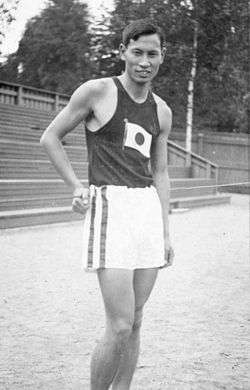Mikio Oda
 | |
| Personal information | |
|---|---|
| Native name | 織田 幹雄 |
| Nationality | Japan |
| Born |
March 30, 1905 Hiroshima, Japan |
| Died |
December 2, 1998 (aged 93). Fujisawa, Kanagawa, Japan |
| Alma mater | Waseda University |
| Height | 1.67 m (5 ft 6 in) |
| Weight | 65 kg (143 lb) |
| Sport | |
| Sport | Athletics |
| Club | Waseda University, Tokyo |
Medal record
| |
Mikio Oda (織田 幹雄 Oda Mikio, March 30, 1905 – December 2, 1998) was a Japanese athlete and the first Japanese Olympic gold medalist. He was the first Asian Olympic champion in an individual event.[1][2]
Biography
Oda was a native of what is now part of Hiroshima city. At the age of 17, he set a new Japanese record for the triple jump at the 1923 Far Eastern Championship Games held in Osaka, and also won the long jump and high jump events.[3] He was selected as a member of the Japanese Olympic team for the 1924 Summer Olympics in Paris, participating in all three events. However, he failed to reach the semifinals in the long jump and high jump, and placed sixth in the triple jump competition.[1]
On his return to Japan, he enrolled at Waseda University, but returned to compete in the 1928 Summer Olympics in Amsterdam. Although he again did not reach the semifinals in the long jump and high jump, he won the triple jump event with a result of 15.21 meters, becoming the first Japanese athlete to win an Olympic gold medal.[1]
In 1931, Oda graduated from Waseda University and was employed by the Asahi Shimbun newspaper. On October 27 of the same year, he established a new world record for the triple jump of 15.58 meters. Oda served as coach and captain of the Japanese athletics team at the 1932 Summer Olympics in Los Angeles.[1]
Upon retirement from competitive athletics, he focused his efforts on sports administration, becoming a member of the Japanese Olympic Committee in 1948 and later taking part in the IAAF's technical committee. He also served as coach for the Japanese athletics team at the 1952 Summer Olympics at Helsinki and the 1954 Asian Games in Manila.[1] During the 1964 Summer Olympics in Tokyo, the Olympic flag was raised to a height of exactly 15.21 meters, to pay respect to Oda's achievement 36 years earlier.
Oda field, a 400-meter running track in Yoyogi built for the 1964 Olympics, was named after Oda.[4] His sporting achievements were recognized with the creation of the Mikio Oda Memorial International Amateur Athletic Game, an annual track and field competition that has been held since 1967.[2]
He became a professor at Waseda University from 1965. In 1976, Oda was awarded the Olympic Order, the highest award of the Olympic Movement. In 1988, Oda was honored by the government as a Person of Cultural Merit, and in 1989, he was named honorary chairman of the Japan Association of Athletics Federations . In the final years of his life, Oda moved from his home at Aburatsubo in Yokosuka, Kanagawa to a nursing home in Kugenuma (Fujisawa, Kanagawa). His grave is at the Buddhist temple of Tokei-ji in Kamakura.
In 2000, Oda was posthumous chosen as the best Asian male athlete of the century by a panel of track and field experts.
References
- 1 2 3 4 5 Mikio Oda. sports-reference.com
- 1 2 Interview with Mikio Oda, first Japanese Olympic gold medallist. IAAF. Retrieved on 2010-04-26.
- ↑ Far Eastern Championships. GBR Athletics. Retrieved on 2014-12-18.
- ↑ Shibuya City Hall Shibuya City Office / Public Facilities Retrieved on October 21, 2013
External links
| Wikimedia Commons has media related to Mikio Oda. |
| Records | ||
|---|---|---|
| Preceded by Nick Winter |
Men's Triple Jump World Record Holder 27 October 1931 – 14 August 1932 |
Succeeded by Chūhei Nambu |